With an enticing cost of living, it has been steadily capturing the hearts of Colombia expats from all over the globe, promising them a stimulating fresh start, a thrilling new chapter in their lives.
If you thrive in the pulsating rhythm of city life, the dynamic urban sprawls of Bogotá and Medellín will be your playground, teeming with energy and life.
On the other hand, if you're a nature aficionado with an unquenchable thirst for breathtaking vistas, the serene parks nestled in the majestic Andes mountains or the pristine, sandy beaches kissing the Caribbean coast are waiting to satisfy your wanderlust.
So, whether you're an urbanite or a nature enthusiast, rest assured, Colombia has a corner carved just for you that fits snugly with your lifestyle, ready to welcome you into its passionate embrace.
Secure Peace of Mind with Best-Value International Health Coverage
International Citizens Insurance provide free, no-obligation quotes from the leading international health insurance providers with plans tailored to meet your needs. Trusted by thousands of expats worldwide.
In this guide:
- Colombia's highlights.
- The legalities of moving to Colombia: visas and residency options.
- The cost of living: monthly expenses, rentals, and real estate.
- Colombia as a retirement destination.
- Infrastructure: travel connections, public transportation, internet.
- Safety
- Healthcare.
- Where to live in Colombia – an overview of the most popular expat locations.
- Culture and lifestyle.
Living in Colombia: the highlights
The population & people of Colombia
Colombia, located in South America, is the fourth most populous country in Latin America, with an estimated population of 50 million people.
Living here, you'll notice the diverse ethnic and cultural composition of its population, which includes indigenous groups, African descendants, and a strong European influence.
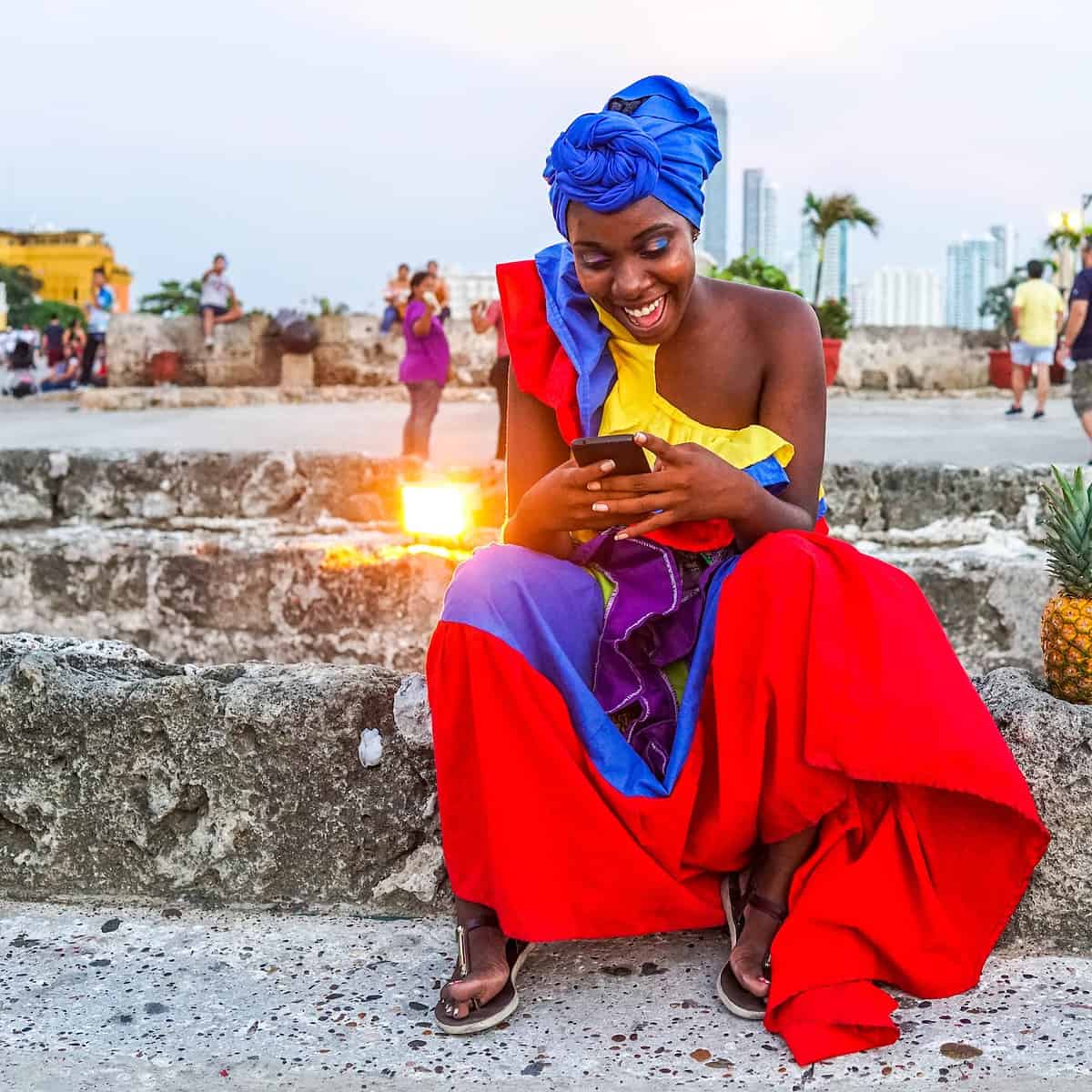
Language
The official language of Colombia is Spanish, spoken by nearly all Colombians.
As an expat, learning to speak Spanish can help you immensely in your day-to-day life, as it allows you to communicate with locals, navigate throughout the country, and fully immerse yourself in Colombia's rich lifestyle.
While some people may speak English, especially in tourist areas, it's generally not widely spoken, so be prepared to brush up on your Spanish skills.
The good news is that Colombian Spanish is considered to be one of the most neutral and easy-to-understand forms of Spanish spoken in South America.
Colombia's climate
The climate in Colombia varies greatly depending on the region:
- Andes Mountains: The Andes Mountains run through Colombia, dividing it into three branches. The climate in this region is cooler, with temperatures typically ranging from 10°C to 19°C (50°F to 66°F).
- Caribbean Coast: Colombia's Caribbean coast boasts warm tropical weather, usually around 28°C (82°F). Coastal cities like Cartagena and Barranquilla are usually hot and humid throughout the year.
- Pacific Coast: The Pacific Coast region has a hot and humid climate, often characterized by heavy rainfall. This area is home to lush rainforests, diverse ecosystems, and unique wildlife.
Colombia experiences two main seasons - the "dry season" from December to March and the "wet season" from April to November.
However, being close to the equator, the country generally enjoys mild temperatures throughout the year.
Geography
Colombia is the 2nd most biodiverse country in the world, with a diverse geography that offers a variety of landscapes to explore and enjoy:
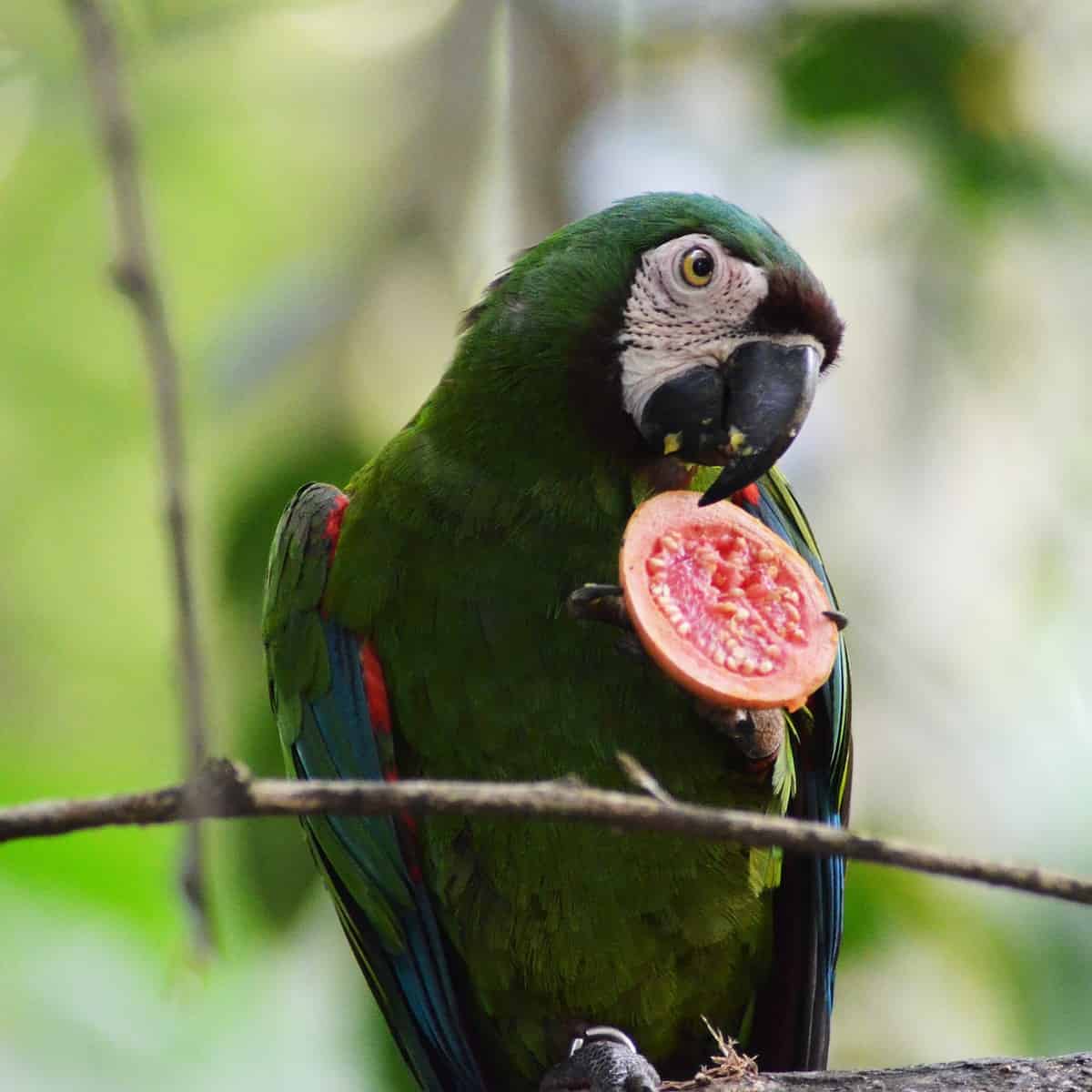
- Mountain regions: The Andes Mountains stretch over much of Colombia, providing breathtaking landscapes, rich agricultural lands, and vibrant cities such as Bogotá, Medellín, and Cali.
- Beaches: The Caribbean and Pacific coasts offer beautiful beaches, crystal-clear waters, and popular tourist destinations like the Rosario Islands and Tayrona National Park.
- Amazon Rainforest: The Colombian Amazon covers a large portion of the country's southeastern border and is home to a diverse array of flora, fauna, and various indigenous communities.
As you live in Colombia, take the time to explore these various regions and appreciate the country's stunning natural beauty.
Visas and legal requirements for Colombia
Columbia offers several categories of visas:
V visas for temporary stay (Visitor visas)
To visit Colombia as a foreigner, you can apply for a visitor visa. This visa allows you to stay in the country temporarily. It can be as short as one week or as long as three years. This type of visa does not grant you long-term residency as the M visa does.
V visas encompass a wide range of visas, including a Digital Nomad Visa and a Rentista Visa.
Colombian Digital Nomad Visa
The Colombia visitor visa for digital nomads allows foreigners to live and work remotely in Colombia for a temporary period. The visa is valid for up to two years and allows you to stay in Colombia for a maximum of 180 days or six months in a year.
As a digital nomad, your work should involve providing remote services for foreign companies or starting a digital venture related to information technology.
Colombian Rentista Visa (Annuity Visa)
This visa is for foreigners who receive income from fixed sources such as annuities, rental properties, dividends, or interest. This income cannot be from salaries or commissions.
Previously, the Rentista visa was known as the Migrant (M) visa. However, as of October 2022, it has been changed to a Visitor (V) visa with a maximum duration of 2 years. The Rentista visa does not grant residency or citizenship.
New requirements for the annuity / rentista visa are a criminal record report and insurance, which covers repatriation.
M visas for long stay (Migrant visa
s)If you are planning to stay longer and do not want the limitations of the V visa, such as staying in the country for a maximum of only six months in a year, you need to apply for an M visa.
For the Colombia Pension Visa (retirement visa), you need to receive at least three times the monthly salary, approximately $800.
The Colombia Migrant Business Owner Visa M is ideal for landlords, trust fund holders, or individuals earning a fixed monthly income from sources outside Colombia.
The Colombia Migrant Property Visa M requires a direct foreign investment of at least 350,000,000 Pesos or $87,500 USD in real estate, with the value adjusted annually for inflation.
R visas for permanent residency (Resident visas)
After living in the country with a Migrant type visa for a period of 2-5 years, you can apply for a permanent residency.
The Colombia resident visa requires updating information every five years and proof of staying in the country for at least one day every two years.
After holding the visa for five years, one can apply for Colombian citizenship by demonstrating a genuine residency in Colombia.
The Colombia resident visa allows multiple re-entries into Colombia.
The cost of living in Colombia
In general, the cost of living in Colombia is very affordable. Here's how the country compares to some of the Northern European and North American countries when it comes to the cost of living, including rent:
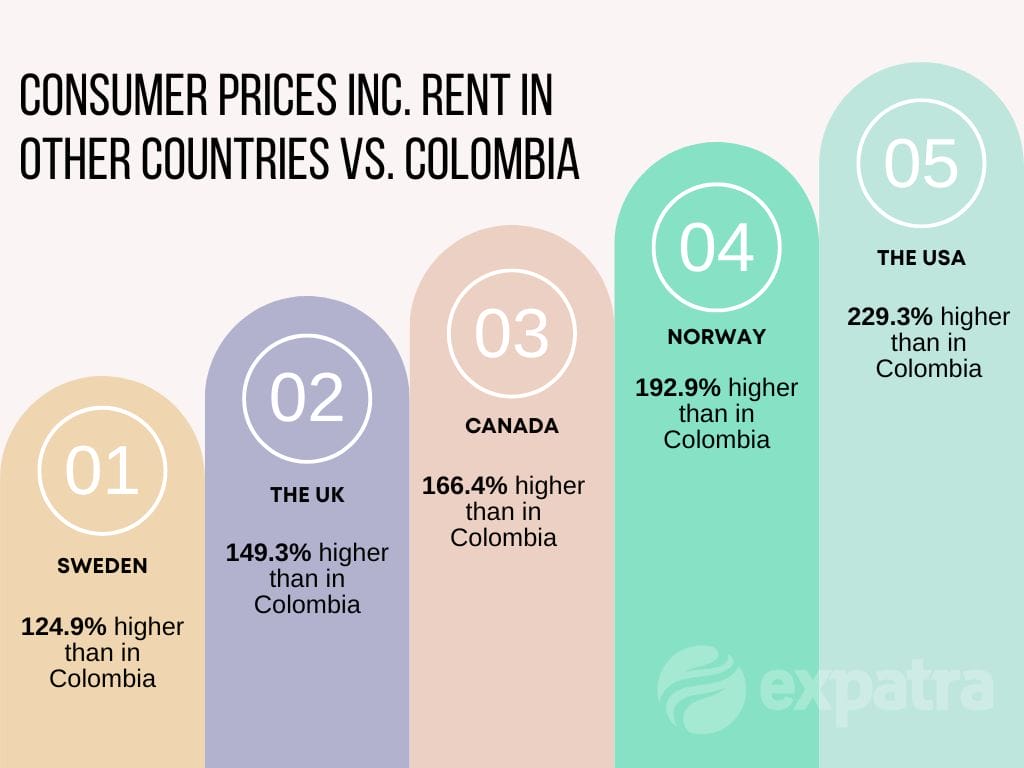
Housing and rent
You will find that even the most popular areas in cities are quite affordable when it comes to rent. Here are the average rental costs in Colombia's various cities:
| City | Average rent for a 1-bed apartment |
|---|---|
| Bogotá | $800 |
| Medellín | $700 |
| Cartagena | $600 |
| Cali | $550 |
| Barranquilla | $500 |
| Santa Marta | $450 |
Real estate prices
Real estate prices depend on the size and quality of the property you are buying and on the area. For instance, a large two-story Poblado home could cost $1 million or more, but a similar home in Manizales or Pereira would only set you back $250,000 to $300,000.
Various types of properties are available for sale:
- Apartments are prevalent in urban areas. The average price varies depending on the city and location, but you can find options starting from around $50,000 and going up to several hundred thousand dollars.
- Condos are often found in gated communities or residential complexes, with prices starting from approximately $80,000 and going up depending on location, size, and amenities.
- Houses usually come with a yard and more space. The average price can range from around $100,000 for smaller properties in suburban areas to several hundred thousand dollars for larger houses in desirable locations.
- Villas are generally luxury properties that come with larger plots of land, upscale features, and often exclusive access to amenities. The average price can range from hundreds of thousands to several million dollars, depending on the location and level of luxury.
Monthly expenses
Here is a breakdown of average monthly expenses in Colombia for a couple:
- Groceries: On average, a couple spends around $200 to $300 on groceries per month.
- Utilities (electricity, water, and gas): A rough estimate could be around $70 to $120 per month.
- Internet: The cost of internet service can range from $30 to $50 per month, depending on the provider and the plan chosen.
- Mobile phone: A typical plan may cost approximately $20 to $50 per person.
- Eating out: Dining out can be affordable in Colombia. The cost of a meal at a local restaurant typically ranges from $5 to $15 per person. Including occasional outings, a couple may spend around $150 to $200 per month on eating out.
- Transportation: Public transportation fares are relatively low, with an average monthly cost ranging from $30 to $60 per person.
Colombia as a retirement destination
According to the Expatra Global Retirement Index, Colombia is in the top 20 best countries to retire in the world.
The index is based on the Expatra Global Retirement Survey that asks international retirees to rate their retirement destination’s infrastructure, climate, ease of settling down, value for money, friendliness, and other aspects of life in their retirement destination.
Here's how Colombia scores:
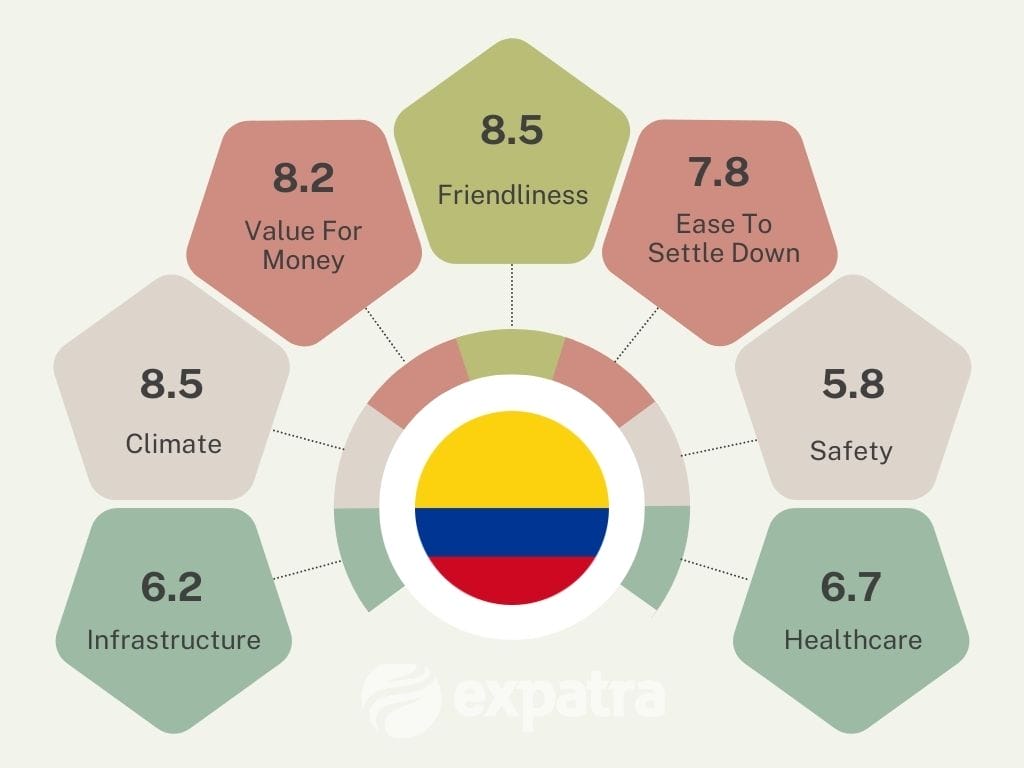
Retirement visa (Colombia pension Visa) requirements:
- Age requirement: 65 years for men and 57 years old for women.
- Proof of pension: You must have a regular pension or retirement income from a reliable source outside of Colombia, such as a government pension or private retirement fund. The income should be at least three times the Colombian minimum wage.
- Proof of funds: You need to demonstrate that you have sufficient funds to support yourself in Colombia. This can be shown through bank statements or other financial documents.
- Health insurance: You must have valid health insurance coverage for your stay in Colombia. This can be either an international health insurance policy or a Colombian health insurance policy.
- Background check: You will be required to provide a criminal record certificate from your country of residence for the past five years. This document usually needs to be apostilled or legalized.
- Visa application form: You need to complete the online visa application form and provide all the necessary documents as per the requirements outlined by the Colombian Consulate or Embassy in your country.
- Passport: Your passport must be valid for at least six months beyond your intended stay in Colombia.
The retirement visa is valid for three years; after that, you need to renew it. After five years, you can apply for a resident visa.
You must stay in Colombia for 180 days or more to keep your visa valid.
Taxes in Colombia
According to Colombian tax laws, you are considered a tax resident in Colombia if:
- You stay in Colombia for a total of 183 days or more within a calendar year, whether they are consecutive or not.
- Your center of vital interests is in Colombia. This means that your main economic and personal activities are carried out in Colombia.
Once you are recognized as a tax resident in Colombia, you are required to report and pay taxes on your worldwide income. This includes income earned from employment, self-employment, investments, pensions, and any other sources, both inside and outside of Colombia.
All visitor visas (type V) make you a non-resident for tax in Colombia, as you can only stay six months a year.
Colombia taxes foreign pensions the same way as any other personal income.
Colombia's income tax rates for residents range from 0% to 39%. The rates are divided into different income brackets, and each bracket has its corresponding tax rate.
Safety and security
Crime rates in Colombia
While Colombia has significantly reduced crime rates and is a long way from when the cities were regarded as some of the most dangerous cities, it's important to remember that crime still exists, especially in larger cities.
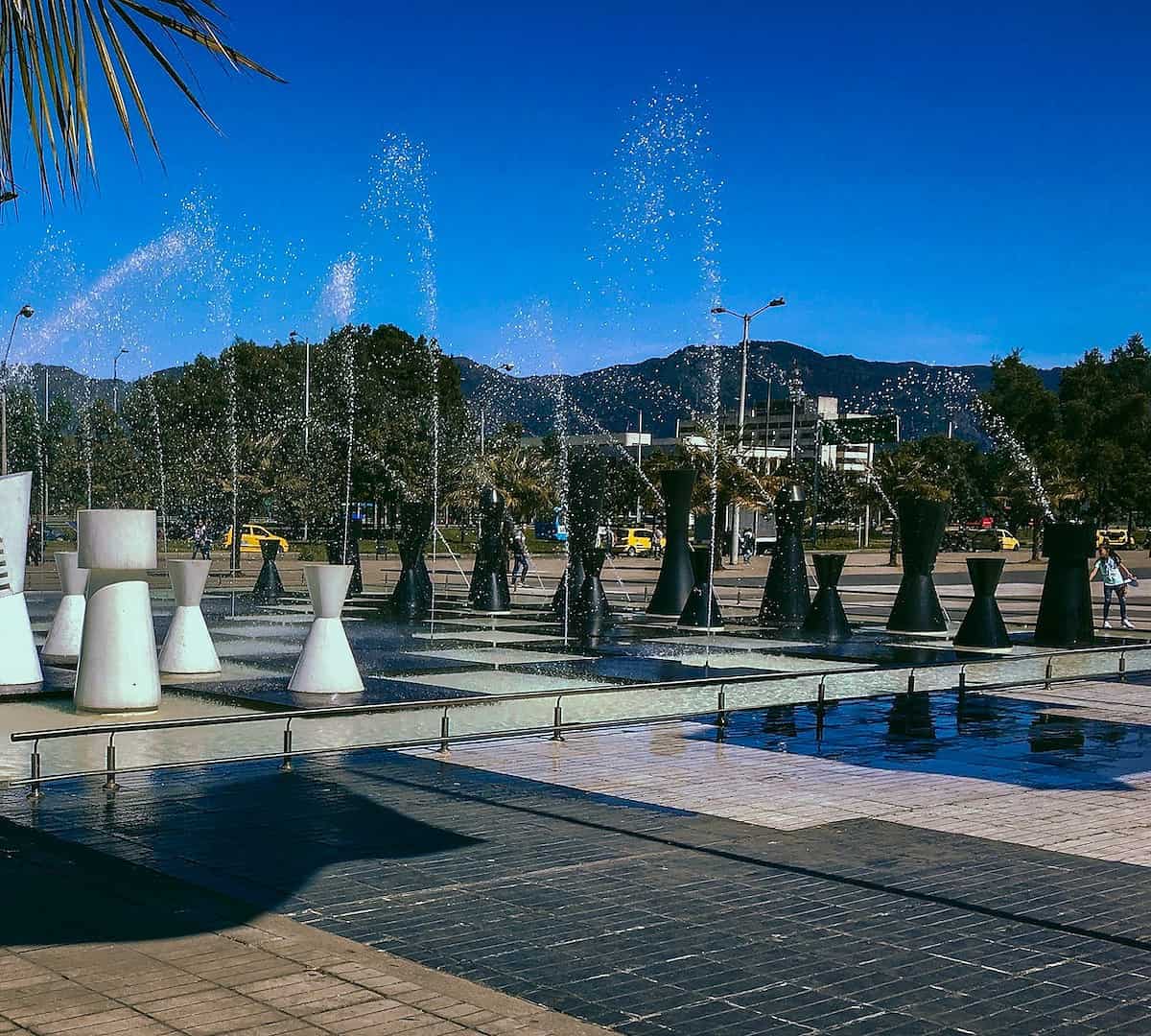
Petty crimes like muggings and robberies can occur, but you can mitigate risks associated with these incidents by taking precautionary measures and staying informed of local conditions.
Most expats say that they feel perfectly safe in the areas of Colombia they live in and visit.
Safety in major cities
Here's a brief overview of safety in major Colombian cities:
- Bogotá: As the capital city, Bogotá sees a higher number of crimes compared to smaller cities; it is considered one of the world's riskiest cities, alongside Mexico City and Rio de Janeiro. However, areas like Chapinero Zona G, Usaquén, and Parque de la 93 are considered safer.
- Medellín: Once notorious for drug-related crimes, Medellín has seen a significant transformation in recent years. Areas like Poblado and Envigado are popular among expats and generally safer.
- Cartagena: This popular tourist destination can attract opportunistic criminals. Stick to well-lit areas, avoid displaying valuables, and exercise caution when visiting crowded places.
- Cali: While some neighborhoods are relatively safe, others are best avoided. Talk to locals and fellow expats to get advice on specific areas to avoid.
Personal security tips
To enhance your safety while living in Colombia, follow these personal security tips:
- Stay aware of your surroundings and exercise caution, especially at night or when walking alone.
- Keep your belongings secure, and avoid publicly displaying expensive items like smartphones or jewelry.
- Don't carry large amounts of cash, and consider using a money belt or hidden pouch for important documents and valuables.
- Opt for reputable transportation: Use authorized taxi services or ride-sharing apps rather than hailing cabs off the street.
- Build connections with locals, expats, and other travelers to stay informed about potential safety concerns in your area.
Healthcare
Colombia provides a world-class healthcare system, considered one of the best in Latin America. In 2021, it ranked 22nd out of 191 countries, beating both Canada and the US, in the World Health Organization health system review.
Private healthcare is also available in Colombia and is generally of a very high standard.
If you are thinking of getting international health insurance, you can compare the prices of leading health insurance providers.
The healthcare system of Colombia
The public healthcare system, known as EPS, offers a three-tiered system with affordable co-payments for lab tests, imaging procedures, specialist visits, and medications.
The co-payments change annually, and many retired expats fall into the second tier.
If you prefer a more personalized service or quicker access to specialists, the private health insurance system might be a better option for you as an expat.
The cost of health services in Colombia's private system remains quite affordable compared to other countries.
Some advantages of the healthcare system include:
- Public health services provide insurance coverage for your spouse and children for free.
- Colombia has many world-class hospitals and medical facilities, enhancing the overall quality of life.
Travel and transportation
International travel
The main point of entry for international flights is El Dorado International Airport in Bogotá. Several international airlines serve Colombia, offering flights to various destinations.
Apart from flying, you can also explore the rest of South America by land or by sea. Bus services are available for connections to neighboring countries such as Ecuador, Peru, or even Brazil.
If you are planning to experience the coastal regions of Colombia, consider a trip to Cartagena, where you can find cruise ships that make stops along the coastline.
Take note of these points for international travel:
- The main point of entry for international flights: El Dorado International Airport
- Numerous airlines serve Colombia, providing worldwide connections
- Buses, cruises, and land travel options are available for regional exploration
Domestic transportation
In Colombia, you will find various ways to move around the country. Buses are the most popular and budget-friendly option, particularly for long-distance travel.
They are quite accessible and will take you to most places, regardless of the terrain, including the colorful and unique buses often seen throughout the country.
If you settle in one of the cities, you'll have all of the expected options, such as buses, taxis, and ridesharing services.
In big cities like Bogotá, you can rely on the TransMilenio bus network, which is efficient and runs on dedicated lanes. Use the TransMi App to check routes and schedules.
Calí has a similar system called Masivo Integrado de Occidente (Mio) that you can use for your transportation needs.
Some highlights in domestic transportation:
- Buses are efficient and budget-friendly for long-distance travel.
Bogotá's TransMilenio and Calí's Mio make it easy to navigate the cities.
- Taxis and ridesharing services are available throughout the country.
Internet
In major urban areas such as Bogota, Medellin, and Cali, internet service providers offer reliable, high-speed connections via fiber.
Barranquilla, Cartagena, and Bucaramanga also enjoy good internet connectivity.
In urban areas, you can expect speeds ranging from 20 to 100 Mbps. As for prices, they tend to be reasonable, with monthly packages ranging from $30 to $70 USD, depending on the speed and the bundle.
Mobile internet
The major mobile network operators in the country, such as Claro, Movistar, Tigo, and Avantel, offer reliable connections and high-speed data transfers in all urban areas. Users can access 4G LTE (Long-Term Evolution) networks in most urban areas, which provide fast internet speeds suitable for browsing, streaming, and using various online services.
However, in more remote or rural areas, the internet connection can be patchy. Some rural areas may still have limited or no access to 4G networks, relying on 3G or even 2G networks, which offer slower speeds and less reliable connections.
Where to live in Colombia: major cities
Bogotá: a city of contrasts
Bogotá, Colombia's beating heart and the most populous urban sprawl serves a tantalizing cocktail of historical charm, cultural richness, and urban culture.
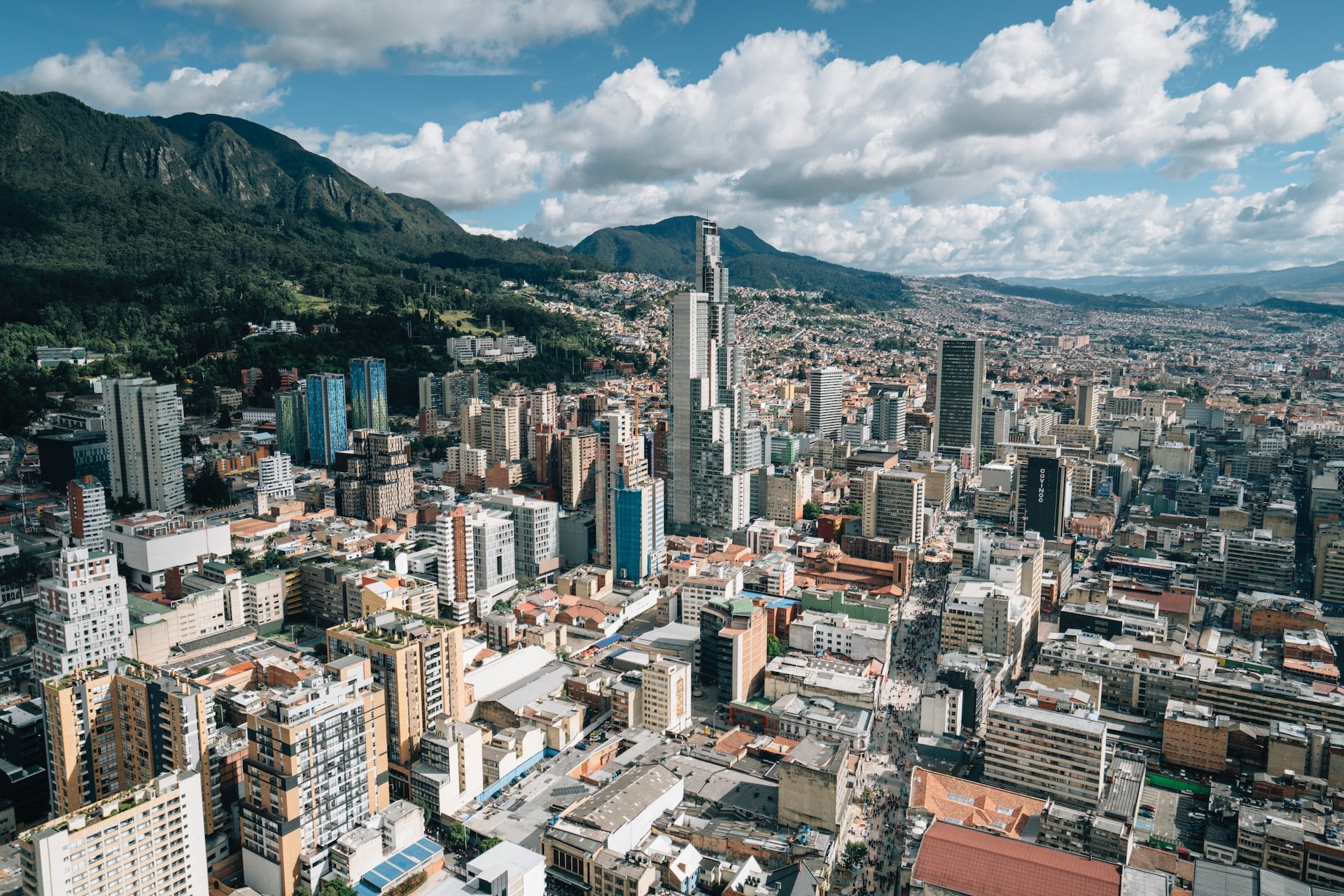
It is Colombia's largest city, where modern architectural marvels reach for the sky alongside well-preserved colonial buildings, and historic museums bear witness to the city's vibrant past amidst a canvas of lively street art.
Bogotá, a city that twinkles with the allure of its emerald markets, is a gastronomic paradise offering one-of-a-kind culinary adventures.
La Candelaria is the city's cultural epicenter. It is a historic neighborhood in the city's downtown, with cobblestone roads and old buildings in Spanish Colonial and Art Deco styles that take you to charming restaurants and numerous museums.
And for the cycling enthusiasts among you, the weekly Ciclovía event is a must-attend. It's a time when the city's arterial routes transform into a haven for pedestrians and cyclists, momentarily free from the hustle and bustle of motorized traffic.
You can find more information in our Living In Bogotá guide.
Medellín
Medellín, once known for its troubled past, has transformed into a modern and vibrant city. Nestled in the Aburrá Valley, you'll be surrounded by green mountains offering stunning views. Medellín is also called the "City of Eternal Spring" for its pleasant year-round weather.
You'll appreciate the efficient public transportation, including the metro and cable cars, and the many cultural events like the annual Flower Festival.
You can find out more in our Living In Medellín guide.
Cartagena
Cartagena is a coastal city that offers beautiful Caribbean beaches perfect for relaxing and enjoying water sports.
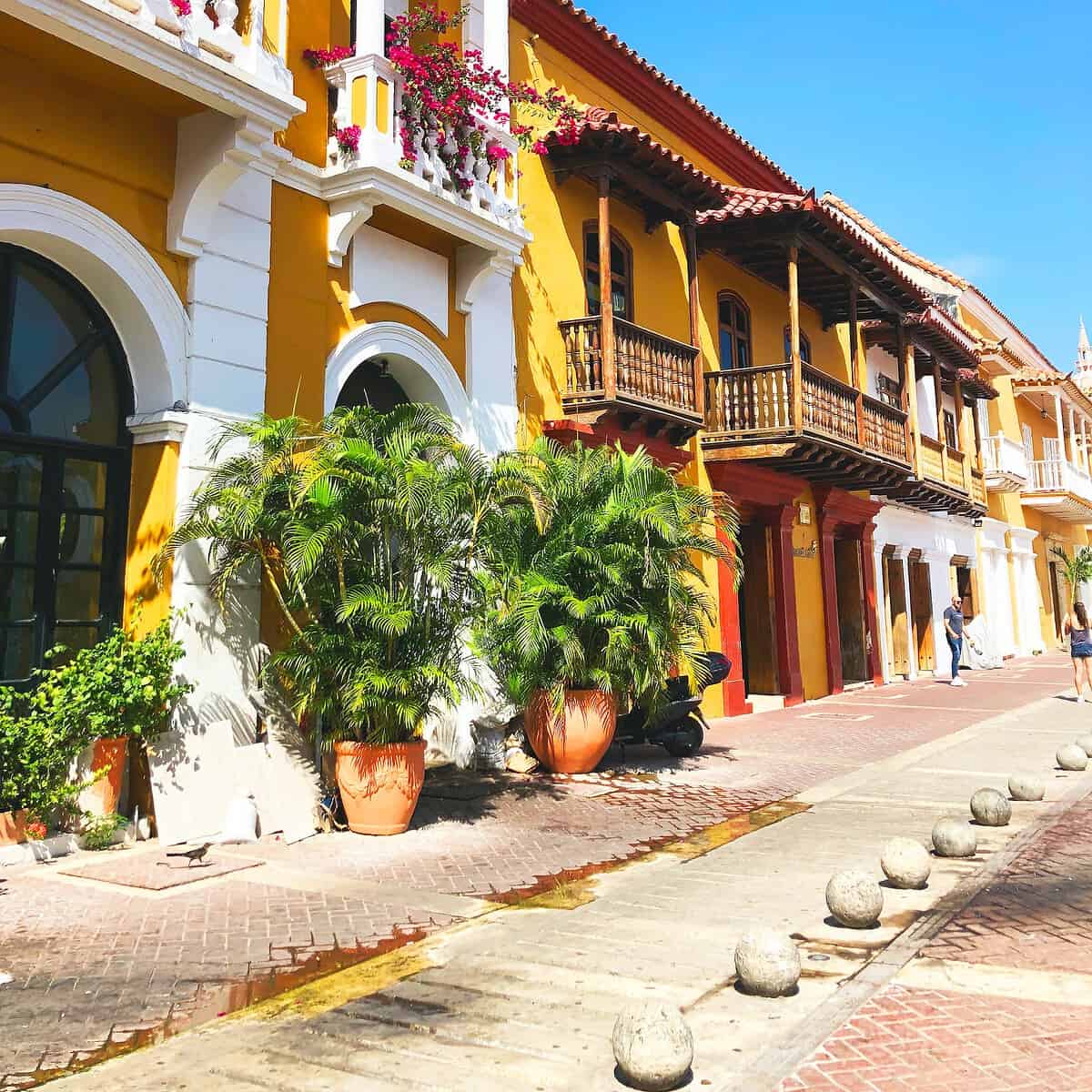
The city's historic walled center is a UNESCO World Heritage Site, featuring gorgeous colonial architecture, cathedrals, and forts. Cartagena's rich history, lively music scene, and mouth-watering cuisine will make living there a genuinely enriching experience.
Santa Marta
Santa Marta is also located on the Caribbean coast of Colombia. Known for its beautiful beaches, it offers a mix of stunning natural landscapes and a rich cultural heritage.
Santa Marta is home to the famous Sierra Nevada mountains, historical sites such as the Santa Marta Cathedral, and a bustling waterfront promenade.
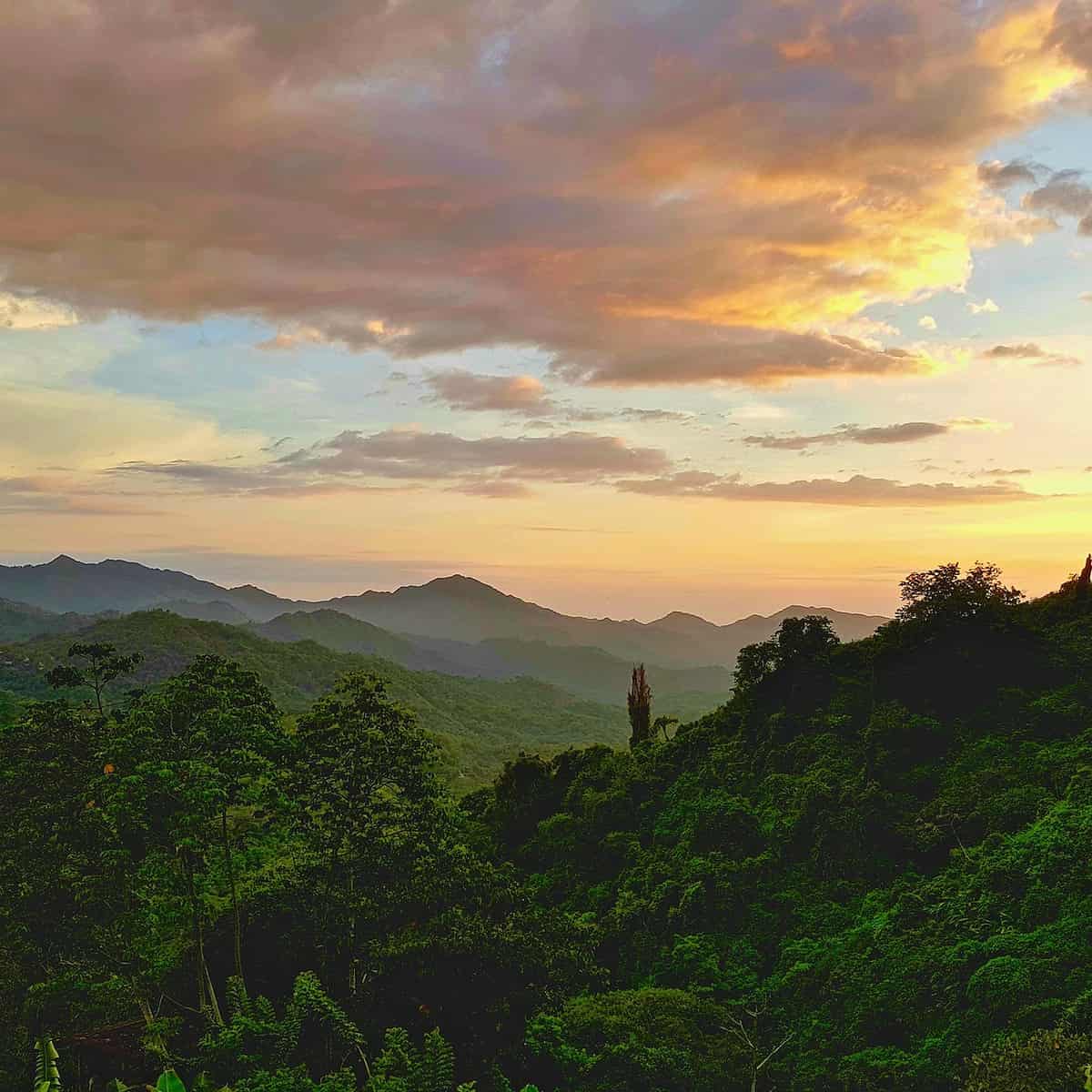
Cali
Colombia's third major city is Cali, known for its salsa music and dance. You'll love the energy and rhythm of the city, as many clubs and music venues host weekly salsa events.
Apart from dancing, you can also explore Cali's lush green landscapes, including the picturesque Pance River and the Farallones de Cali National Park.
Pereira
Pereira, located in the Coffee Triangle of Colombia, offers a laid-back lifestyle amid the breathtaking scenery of coffee plantations.
As you stroll along its streets, you'll notice a fusion of architecture reflecting the city's evolution.
Pereira's moderate climate makes exploring the many parks and plazas pleasant. Plus, you're just a short drive away from the stunning Cocora Valley and Los Nevados National Park.
Manizales
Another city in Colombia's Coffee Triangle, Manizales, boasts stunning views of the central Andean mountains.
Its steep streets and cool, misty weather provide a unique atmosphere to live in. You can enjoy outdoor activities like hiking and birdwatching, as well as visiting coffee farms.
Manizales is also home to several universities, giving it a youthful and diverse vibe.
Rionegro
Rionegro is a smaller city located in the lush green hills of Antioquia. Just a 40-minute drive from Medellín, Rionegro offers both tranquility and easy access to a big city.
With its pleasant climate, beautiful parks, and historic landmarks, Rionegro is an attractive option for those looking for a more relaxed lifestyle while still being close to urban amenities.
Bucaramanga
Bucaramanga, situated in northeastern Colombia, is known as the "City of Parks" for its abundant green spaces.
You'll enjoy a relaxed and peaceful life surrounded by nature, with the picturesque Chicamocha Canyon nearby.
The city's affordable living costs and friendly locals add to its charm while offering a bustling commercial sector and cultural events.
In exploring these cities, you're sure to find the perfect fit for your lifestyle and interests, as Colombia offers something unique for everyone.
For more information and ideas, read our guide on the best places to live in Colombia.
Lifestyle and culture
Living in Colombia, you'll quickly discover that the locals are warm, welcoming, and proud of their rich heritage.
The diversity of Colombia is apparent in the various traditions and customs across the country, which include a unique blend of indigenous, African, and European influences.
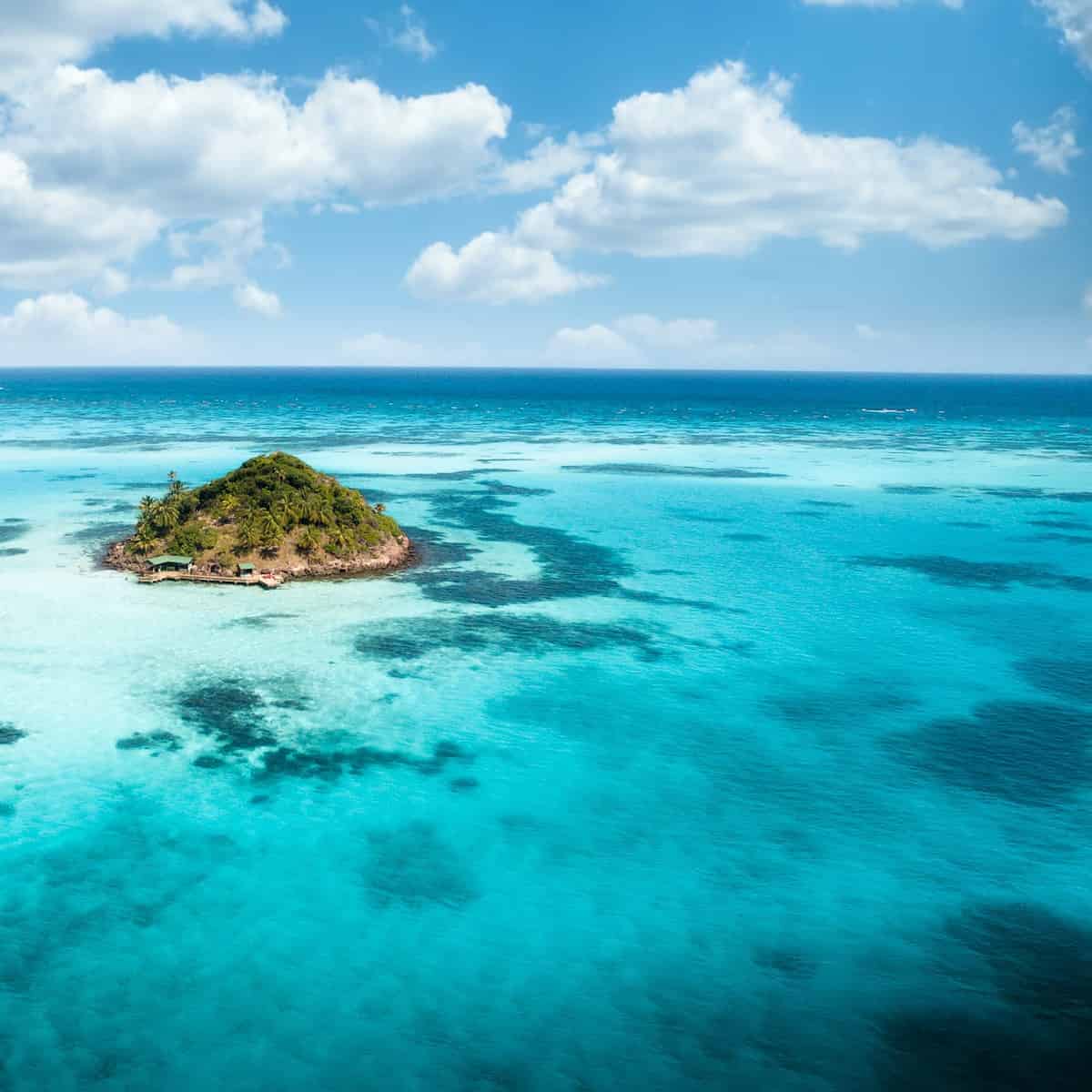
As you immerse yourself in this vibrant culture, you'll find that music and dance play a significant role in everyday life, with styles like salsa, cumbia, and vallenato widely celebrated.
Art and museums
Your appreciation for Colombian culture will only deepen as you explore the country's art scene.
Colombia boasts numerous museums and a wide variety of galleries and museums, including Bogotá’s famous Museo del Oro, home to the largest collection of pre-Columbian gold artifacts, and Medellín’s Museo de Antioquia, where you can admire the works of renowned artist Fernando Botero.
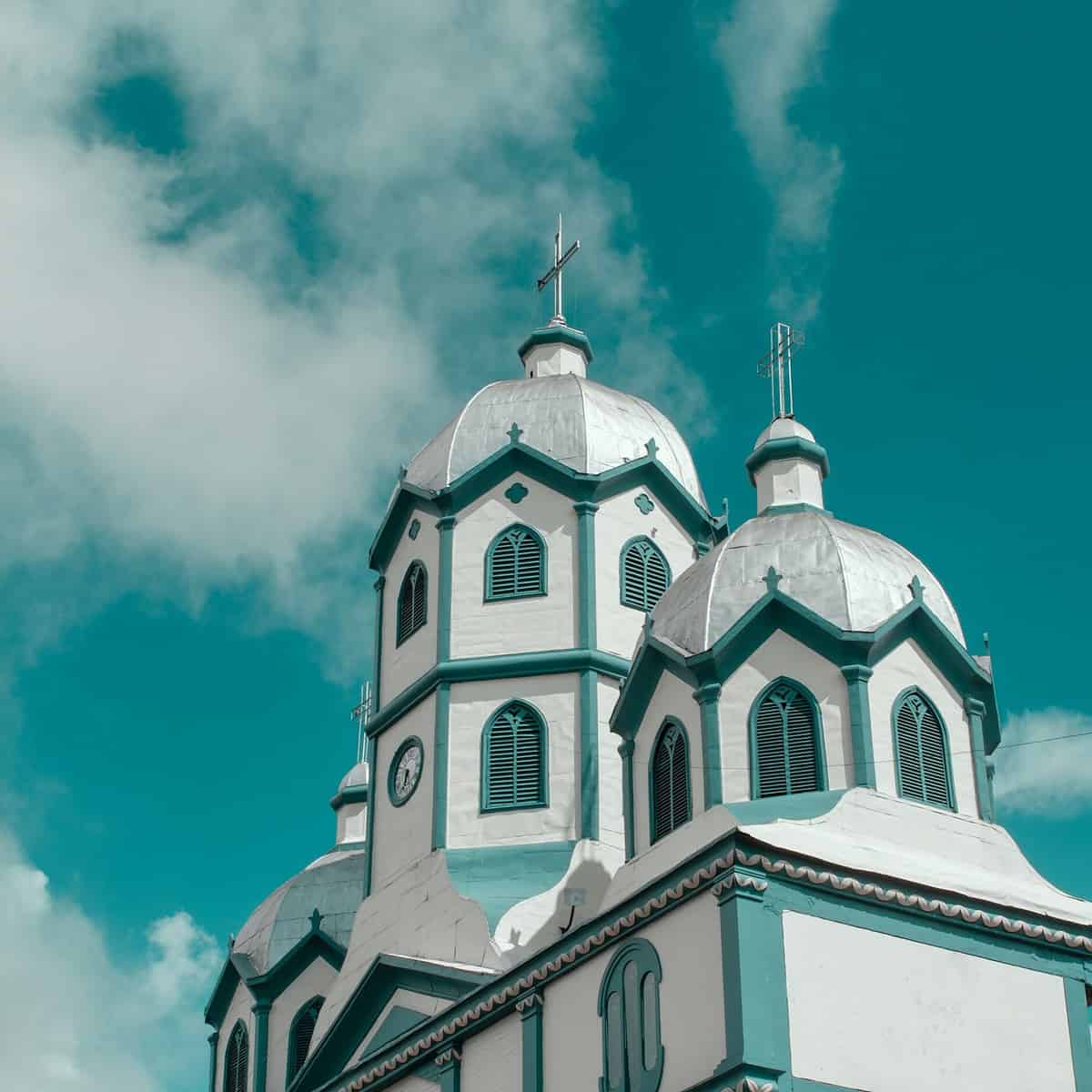
Festivals and cultural events
One of the best ways to experience Colombian culture is by attending one of the numerous festivals and cultural events held throughout the year.
From the colorful Barranquilla Carnival to the Flower Festival in Medellín, each celebration offers a unique opportunity to witness the country's zest for life and creativity.
Gastronomy
As you explore Colombia's diverse culinary scene, you're sure to find your taste buds delighted by the combination of local flavors and international influences.
Colombian cuisine is marked by regional specialties; on the coast, you'll enjoy fresh seafood dishes, while in the Andean region, hearty staples like bandeja paisa dominate.
Don't forget to indulge in a steaming cup of Colombian coffee, as the country is one of the world's top producers.
Parks and recreation
Finally, take advantage of Colombia's vast natural beauty by visiting some of the country's national parks and recreational areas.
The landscapes in Colombia range from pristine beaches and lush rainforests to towering mountains. Colombia expats find no shortage of opportunities to enjoy outdoor adventures or relax in breathtaking surroundings.
Family life
Living in Colombia as a family can be a rich and rewarding experience. The country is known for its warm and welcoming people who value family connections.
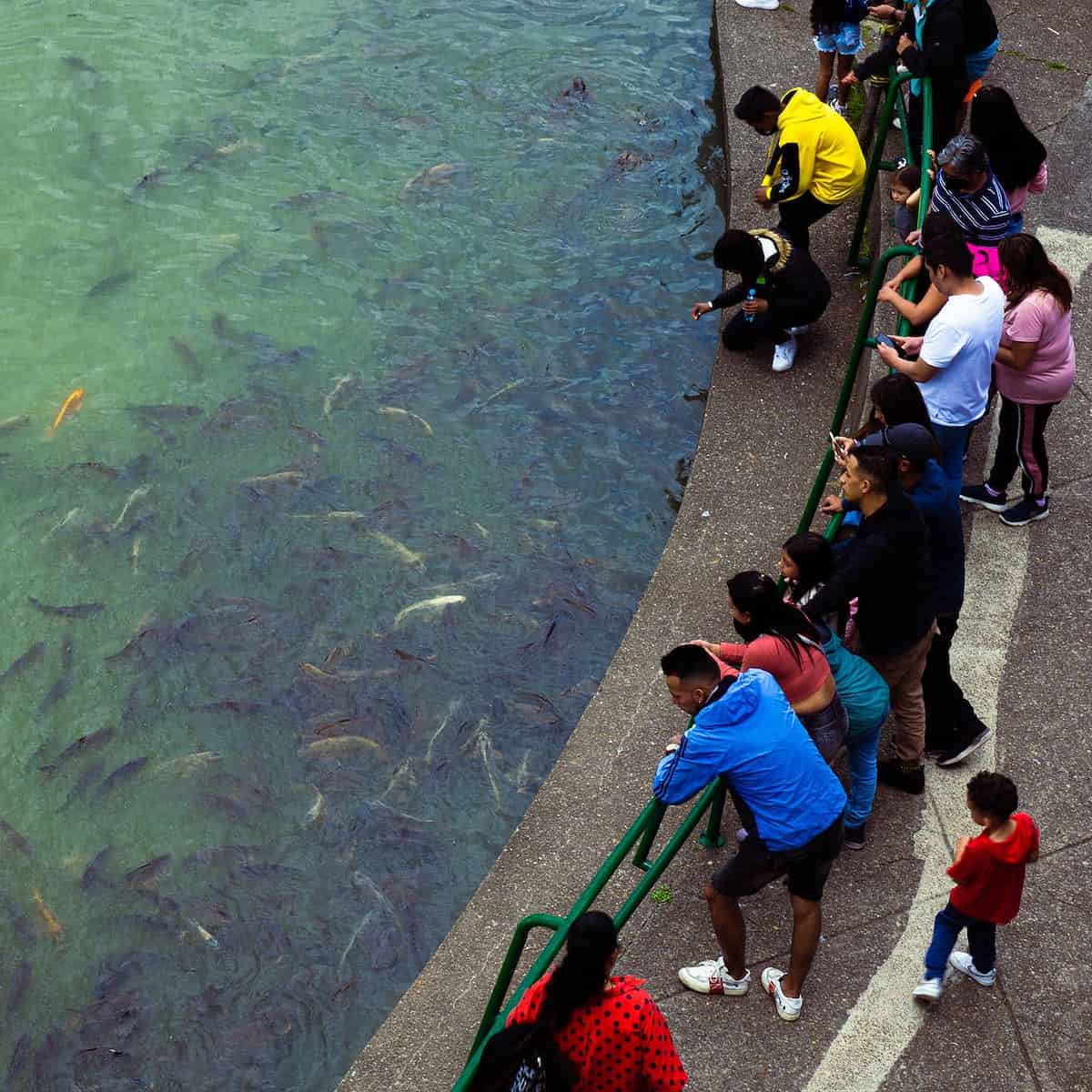
When settling in Colombia, you might find the quality of life to be significantly different compared to your home country.
Expats often live in apartment complexes with good security and access to amenities such as pools and gyms, making them suitable for families.
Learn more about the pros and cons of living in Colombia to ensure a smooth transition for your family.
Business and economy
Economic situation
Colombia's economy has bounced back really well from the COVID-19 crisis. This is thanks to good government policies that have helped prevent a bigger drop in people's incomes.
The country has put in place solid plans to manage its economy, which are helping to revive local spending.
Foreign investment and opportunities
The Colombian economy offers numerous opportunities for investment. Its abundance of natural resources, the promotion of free-trade agreements, and a low cost of living have attracted substantial foreign investment in recent years.
Colombia has a score of 65.1 regarding economic freedom, meaning its economy is considered the 60th freest in the 2022 Index. In comparison to other countries in the Americas region, Colombia ranks 12th out of 32 countries.
If you plan on living in Colombia as a business investor, you may be able to take advantage of the numerous opportunities to establish or expand businesses across various sectors.
Final thoughts on living in Colombia
With a growing economy, attractive investment opportunities, and a vibrant digital nomad community, living in Colombia could provide everything you need to succeed in your personal and professional expat pursuits.
You might find useful:
Helpful external links:
- All about Colombian residency - Colombian government site.
- Health advise for entering Colombia - Colombia Ministry of Health
Further places to explore in Latin America:
- Living In Chile
- Living In Mexico
- Living In Panama
- Living In Costa Rica
- Living In Brazil
- Living In Paraguay
- Living In Ecuador
- Living In Uruguay
Secure Peace of Mind with Best-Value International Health Coverage
International Citizens Insurance provide free, no-obligation quotes from the leading international health insurance providers with plans tailored to meet your needs. Trusted by thousands of expats worldwide.



